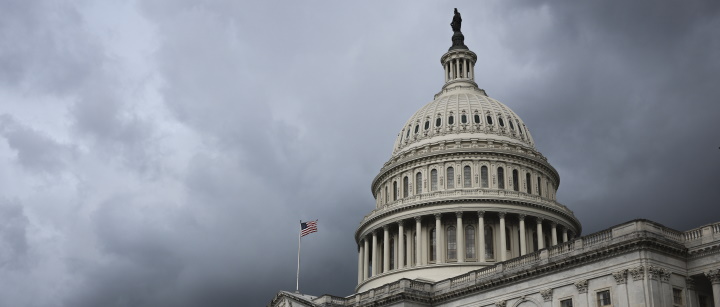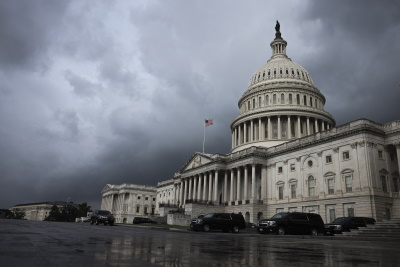
Democrats and Republicans are once again in a standoff over a looming debt limit crisis. Congress must raise or suspend the limit on federal borrowing soon or the U.S. government won’t be able to pay its bills.
Here we provide the facts on the political dispute.
What is the debt limit?
The debt limit is a cap on how much the Treasury Department can borrow to fund federal operations. Congress sets the debt limit, as required by federal law and consistent with the Constitution, which gives Congress the “power of the purse.”

The limit, also known as the debt ceiling, applies to all federal debt — both debt held by the public (money borrowed from sources outside the government) and intragovernmental holdings (money that the government owes itself). Most intragovernmental debt is held by federal trust funds, such as the Social Security trust funds.
“Since 1960, Congress has acted 78 separate times to permanently raise, temporarily extend, or revise the definition of the debt limit – 49 times under Republican presidents and 29 times under Democratic presidents,” Treasury says on its website.
Under President Donald Trump, Congress passed three spending bills — in 2017, 2018 and 2019 — that suspended the debt limit. In each case, the debt limit was then raised at the end of the suspension period to account for the cumulative borrowing that occurred during the suspension, as explained in an April report by the nonpartisan Congressional Research Service:
- On Sept. 8, 2017, a continuing resolution — the Continuing Appropriations Act of 2018 and Supplemental Appropriations for Disaster Relief Requirements Act of 2017 — became law. It suspended the debt limit through Dec. 8, 2017. Once that suspension lapsed, the new debt limit was set at $20.5 trillion to cover the amounts borrowed during the suspension.
- On Feb. 9, 2018, the Bipartisan Budget Act of 2018 suspended the debt limit again through March 1, 2019. At the end of that suspension period, the debt limit was then reset at $22 trillion to accommodate federal obligations during the suspension period.
- The Bipartisan Budget Act of 2019, enacted on Aug. 2, 2019, suspending the debt limit until July 31, 2021. When that suspension lapsed, the debt limit was reset at its level as of Aug. 1, which was $28.4 trillion.
President Joe Biden and the Democrats are now seeking to do what Trump and the Republicans did in 2017, 2018 and 2019: resolve the debt limit issue in a bipartisan manner.
What is the deadline to act now?
Soon — as early as October.
In late July, the nonpartisan Congressional Budget Office estimated Treasury “would probably run out of cash” in October or November if the debt limit isn’t increased. The Bipartisan Policy Center also estimated the “X Date” when the government could no longer fully meet his obligations would be this fall. In a Sept. 21 analysis, Moody’s Analytics said its “best estimate” is that Treasury would default on Oct. 20 if Congress didn’t act.
Treasury Secretary Janet Yellen said in an Aug. 2 letter to Congress that a “debt issuance suspension period” would last through Sept. 30, allowing Treasury to use “extraordinary measures,” which are accounting strategies to manage cash and debt. In a follow-up letter on Sept. 8, Yellen said “the most likely outcome is that cash and extraordinary measures will be exhausted during the month of October.”
The Treasury secretary said how long the extraordinary measures would last “is subject to heightened uncertainty” due to the impact of the coronavirus pandemic.
Yellen’s letters said Treasury had suspended the sale of state and local government securities. It stopped investments credited to the Civil Service Retirement and Disability Fund and the Postal Service Retiree Health Benefits Fund, and suspended certain investments in the Federal Employees’ Retirement System – all of which “will be made whole once the debt limit is increased or suspended.”
Yellen has urged Congress to take action “on a bipartisan basis as it has in the past to protect the full faith and credit of the United States.”
In addition to the debt limit situation, Congress needs to pass legislation to fund the government after Sept. 30, when this fiscal year ends. If it doesn’t, there could be a partial government shutdown, with some services and even federal worker paychecks being cut off.
What is the disagreement between Republicans and Democrats?
On Sept. 21, the House passed a continuing budget resolution that would fund the government through Dec. 3, suspend the debt limit through Dec. 16, 2022, and reset the limit at the amount it will be on Dec. 17, 2022. The bill includes emergency disaster relief and funding to assist refugees and others arriving from Afghanistan. It passed with a straight party-line vote, with zero Republican support.
In a Sept. 20 statement, House Speaker Nancy Pelosi and Senate Majority Leader Chuck Schumer said the bill is needed to prevent a partial government shutdown when the fiscal year ends on Sept. 30. “[A]n extension of government funding through December will provide an appropriate amount of time” needed to pass a full fiscal year 2022 spending package, they said.
But Republicans in the Senate have vowed to reject the continuing resolution, seeking to link a vote on the debt limit solely to the Democrats.
“Senate Republicans would support a clean continuing resolution that includes appropriate disaster relief and targeted Afghan assistance,” Senate Minority Leader Mitch McConnell said in a Sept. 20 floor speech. “We will not support legislation that raises the debt limit.”
The Republicans accuse the Democrats of suspending the debt limit to fund their partisan $3.5 trillion budget resolution and reconciliation plan, which passed the House along party lines in August.
“They are increasing the debt ceiling to make room for a $5.5 trillion Democratic Party wish list,” Sen. Bill Cassidy said on Sept. 19 on “Meet the Press,” using a higher figure that a budget watchdog group says is the “true cost” of the $3.5 trillion plan, although that assumes the policies in the Democratic plan would become permanent in future legislation.
After suspending the debt ceiling, the Senate Democrats hope to approve their $3.5 trillion spending bill through a procedure known as reconciliation, which would require only 51 votes in the Senate. The Democrats control 50 Senate seats, and Vice President Kamala Harris would provide the tie-breaking 51st vote — the bare minimum needed to pass a bill through reconciliation.
In his Sept. 20 floor speech, McConnell urged the Democrats to also raise the debt limit without Republican votes through reconciliation.
“Democrats want to build a partisan future without our input. So Democrats will not get bipartisan facilitators for their purely partisan spending binge,” McConnell said, later adding: “One party controls the entire government. They have the power to address this [debt limit issue] alone.”
Democrats accuse the Republicans of hypocrisy. “This is the same Leader McConnell who urged Democrats and Republicans to support raising the debt ceiling when Donald Trump was president, and he was majority leader,” Schumer said in a floor speech on Sept. 20, noting that the Democrats gave support for all three of those bills and adding that “at least one of those times was when the House, the Senate, and the presidency were controlled by Republicans.”
In September 2017, Democrats did support suspending the debt limit when Republicans controlled Congress and the White House.
Raising the debt limit, Democratic leaders say, is needed to allow the federal government to pay for past spending bills — not future spending, as Republicans have claimed.
“Addressing the debt limit is about meeting obligations the government has already made, like the bipartisan emergency COVID relief legislation from December as well as vital payments to Social Security recipients and our veterans,” Schumer and Pelosi said in their Sept. 20 statement.
In a floor speech that day, Schumer said: “Anyone who says this is Democratic debt is not talking fact. They’re talking fiction.”
How might this be resolved?
Democrats would need to convince 10 senators to support the continuing resolution, which includes disaster relief aid to states hit by hurricanes. Republican Sen. John Kennedy of Louisiana said he would “probably” vote for the bill because of the relief funding, but the state’s other senator, Cassidy, hasn’t said how he’ll vote.
Without sufficient Republican support in the Senate, Democrats would have to pass the continuing resolution through reconciliation. However, instead of suspending the debt limit, a reconciliation bill would have to raise the debt limit by a specific amount — making it a vote Democrats don’t want to solely own.
Roll Call‘s Paul M. Krawzak outlined another possibility: “reopening the fiscal 2022 budget resolution,” which Democrats in both houses of Congress already passed, “to add debt limit language.” But that wouldn’t be easy. “It’s just complicated, it’s not clear the Senate parliamentarian would allow it, and time is short with estimates that the Treasury Department could run out of funds to meet U.S. financial commitments within weeks,” Krawzak wrote in a Sept. 22 analysis.
What happens if it isn’t resolved by Oct. 1?
As we said, if Congress doesn’t pass legislation to keep funding the government beyond Sept. 30, some government services could be curtailed. As for the debt limit, politicians of both parties agree the economic and political fallout would be significant. The government would default on its obligations.
Yellen warned Congress that “waiting until the last minute to suspend or increase the debt limit can cause serious harm to business and consumer confidence, raise short-term borrowing costs for taxpayers, and negatively impact the credit rating of the United States.” In 2011, during another political battle over the debt limit, Standard & Poor’s downgraded the U.S. government’s credit rating.
“A delay that calls into question the federal government’s ability to meet all its obligations would likely cause irreparable damage to the U.S. economy and global financial markets,” Yellen said in her Sept. 8 letter.
Moody’s said if Congress doesn’t act “before the Treasury runs out of cash and defaults on its obligations, interest rates will spike, with enormous costs to taxpayers, consumers and the economy.” Its analysis warns of a recession for both U.S. and global economies, still trying to recover from the economic impact of the coronavirus pandemic.
The budget watchdog Committee for a Responsible Federal Budget wrote in a July 28 post that there is no option beyond getting lawmakers to act.
“Some believe the Treasury Department could buy more time by engaging in other, unprecedented actions such as selling large amounts of gold, minting a special large-denomination coin, or invoking the Fourteenth Amendment to override the statutory debt limit,” CRFB said. “Whether any of these tools is truly available is in question, and the potential economic and political consequences of each of these options are unknown. Realistically, once extraordinary measures are exhausted, the only option to avoid defaulting on our nation’s obligations is for Congress to change the law to raise or suspend the debt ceiling.”
Editor’s note: FactCheck.org does not accept advertising. We rely on grants and individual donations from people like you. Please consider a donation. Credit card donations may be made through our “Donate” page. If you prefer to give by check, send to: FactCheck.org, Annenberg Public Policy Center, 202 S. 36th St., Philadelphia, PA 19104.
The post Debt Limit Q&A appeared first on FactCheck.org.
Source Link Debt Limit Q&A
Leave a Reply